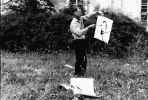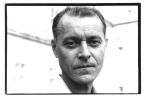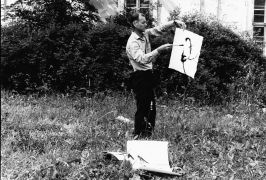"Art is like a long journey which takes one a long distance until reaching a point where there is again a beginning."
Karel Adamus, inspired by Taoist texts, 1992
"The Peripatetic Poems are related to Wind Poems, in which atmospheric conditions, especially the wind, become the predominant feature. The artist allows a sheet of paper to float freely in the breeze. While walking, he applies a brush or pen to it. The touches and coloured lines are not the result of his “writing,” but are aleatoric, a record of the force and direction of the wind. By using rolled paper, paintbrushes and ink, fascinating associations with far Eastern calligraphy arise."
Martin Mikolášek
Karel Adamus (born 1943 in Pilsen) is a Czech poet and visual artist, living and working in Třinec. Initially, Adamus operated within usual semantic boundaries, but later shifted to the sphere of visual poetry. By the end of the sixties, he was creating his first poetic images, in which he worked with the word not as the bearer of meaning but as a graphic symbol.
Adamus refers to his work as visual poetry containing several semantic subgroups. These include Cigarette Poems (1969–1970), which work with burning paper and the transparency of its individual layers. Another subgroup would be Mobile Poems (1970–1971), in which Adamus included movement in the structure and form of a poem: by rotating the individual elements, the viewer creates their own text and method of reading. The visual poems would include Poems of the Score (1973–76), an original contribution to musical scores created within the tradition of minimalism.
Since the 1970s, the artist has also been working with Poems of Objects and Object Poems, in which he consciously draws on the work of his predecessors, especially Jiří Kolář. From the original inspiration emphasizing poeticisation, Adamus has shifted to a distinctive authorial contribution. His objects, collages and assemblages are characterised not only by a Dadaist playfulness, but also the permanent presence of visual metaphor that is a fundamental component of most of his works.
The procedure and movement present in his Mobile Poems as far back as the 1970s continues to predominate in the Peripatetic Poems, during the creation of which the artist returned to paper. He created artefacts, genuine poems without visual and rational control, sometimes moving beyond the alphabet itself. The poems came into being during walks and the resulting visual form is influenced by the environment (mountain excursion, etc.) and climate. Adamus thus brought many new ideas to Czech art of the latter half of the twentieth century, both in terms of the deliberate inclusion of the environment in which the work was created, and in the explication of psychomotorism as an important aspect in the resulting form of the work.
The Peripatetic Poems are related to the Wind Poems, in which atmospheric conditions, especially the wind, become the predominant feature. The artist allows a sheet of paper to float freely in the breeze. While walking, he applies a brush or pen to it. The touches and coloured lines are not the result of his “writing,” but aleatoric, a record of the force and direction of the wind. By using rolled paper, paintbrushes and ink, fascinating associations with far Eastern calligraphy arise.
As well as the visual poems, which over the last decade have been few and far between, Adamus has concentrated on the written text, in which the inspiration of eastern philosophy is clear. A cycle of these short stories and ideations has been published in several parts under the generic title Po dně a podněžníci / Along the Bottom and Bottom Dwellers.
Martin Mikolášek, taken from: https://www.artlist.cz/karel-adamus-108550/












